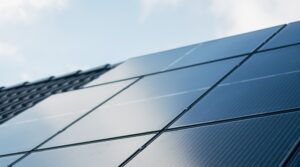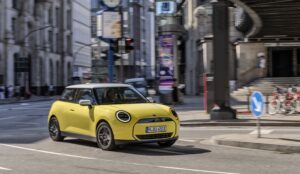Tom Baxter from the University of Aberdeen outlines why hydrogen cars are hampered by the laws of science.
Hydrogen has long been touted as the future for passenger cars.
The hydrogen fuel cell electric vehicle (FCEV), which simply runs on pressurised hydrogen from a fuelling station, produces zero carbon emissions from its exhaust. It can be filled as quickly as a fossil-fuel equivalent and offers a similar driving distance to petrol.
It has some heavyweight backing, with Toyota, for instance, launching the second-generation Mirai later in 2020.
The Canadian Hydrogen and Fuel Cell Association recently produced a report extolling hydrogen vehicles. Among other points, it said that the carbon footprint is an order of magnitude better than electric vehicles: 2.7g of carbon dioxide per kilometre compared to 20.9g.
All the same, I think hydrogen fuel cells are a flawed concept. I do think hydrogen will play a significant role in achieving net-zero carbon emissions by replacing natural gas in industrial and domestic heating.
But I struggle to see how hydrogen can compete with electric vehicles, and this view has been reinforced by two recent pronouncements:
A report by BloombergNEF concluded: ‘The bulk of the car, bus and light-truck market looks set to adopt battery-electric technology, which are a cheaper solution than fuel cells.’
Volkswagen, meanwhile, made a statement comparing the energy efficiency of the technologies. ‘The conclusion is clear’ said the company. ‘In the case of the passenger car, everything speaks in favour of the battery and practically nothing speaks in favour of hydrogen.’
Hydrogen’s efficiency problem
The reason why hydrogen is inefficient is because the energy must move from wire to gas to wire in order to power a car. This is sometimes called the energy vector transition.
Let’s take 100 watts of electricity produced by a renewable source such as a wind turbine. To power an FCEV, that energy has to be converted into hydrogen, possibly by passing it through water (the electrolysis process). This is around 75% energy-efficient, so around one-quarter of the electricity is automatically lost.
The hydrogen produced has to be compressed, chilled and transported to the hydrogen station, a process that is around 90% efficient. Once inside the vehicle, the hydrogen needs to be converted into electricity, which is 60% efficient. Finally, the electricity used in the motor to move the vehicle is around 95% efficient. Put together, only 38% of the original electricity — 38 watts out of 100 — are used.
With electric vehicles, the energy runs on wires all the way from the source to the car. The same 100 watts of power from the same turbine loses about 5% of efficiency in this journey through the grid (in the case of hydrogen, I’m assuming the conversion takes place onsite at the wind farm).
You lose a further 10% of energy from charging and discharging the lithium-ion battery, plus another 5% from using the electricity to make the vehicle move. So you are down to 80 watts — as shown in the figure opposite.
In other words, the hydrogen fuel cell requires double the amount of energy. To quote BMW: ‘The overall efficiency in the power-to-vehicle-drive energy chain is therefore only half the level of [an electric vehicle].’
Swap shops
There are around 5 million electric vehicles on the roads, and sales have been rising strongly.
This is at best only around 0.5% of the global total, though still in a different league to hydrogen, which had achieved around 7,500 car sales worldwide by the end of 2019.
Hydrogen still has very few refuelling stations and building them is hardly going to be a priority during the coronavirus pandemic, yet enthusiasts for the longer-term point to several benefits over electric vehicles: drivers can refuel much more quickly and drive much further per “tank”. Like me, many people remain reluctant to buy an electric car for these reasons.
China, with electric vehicle sales of more than one million a year, is demonstrating how these issues can be addressed. The infrastructure is being built for owners to be able to drive into forecourts and swap batteries quickly. NIO, the Shanghai-based car manufacturer, claims a three-minute swap time at these stations.
China is planning to build a large number of them. BJEV, the electric-car subsidiary of motor manufacturer BAIC, is investing €1.3 billion (£1.2 billion) to build 3,000 battery charging stations across the country in the next couple of years.
Not only is this an answer to the ‘range anxiety’ of prospective electric car owners, but it also addresses their high cost. Batteries make up about 25% of the average sale price of electric vehicles, which is still some way higher than petrol or diesel equivalents.
By using the swap concept, the battery could be rented, with part of the swap cost being a fee for rental. That would reduce the purchase cost and incentivise public uptake. The swap batteries could also be charged using surplus renewable electricity — a huge environmental positive.
Admittedly, this concept would require a degree of standardisation in battery technology that may not be to the liking of European car manufacturers. The fact that battery technology could soon make it possible to power cars for a million miles might make the business model more attractive.
It may not be workable with heavier vehicles such as vans or trucks, since they need very big batteries. Here, hydrogen may indeed come out on top.
Finally a word on the claims on carbon emissions from that Canadian Hydrogen and Fuel Cell Association report I mentioned earlier. I checked the source of the statistics, which revealed they were comparing hydrogen made from purely renewable electricity with electric vehicles powered by electricity from fossil fuels.
If both were charged using renewable electricity, the carbon footprint would be similar. The original report was funded by industry consortium H2 Mobility, so it’s a good example of the need to be careful with information in this area.
This article is republished from The Conversation under a Creative Commons license. Read the original article here.
Photo Credit – Pixabay

















I still think hydrogen has some clear advantages over electric but maybe it is a VHS vs Betamax thing
Hydrogen fuel cell vehicles aren’t likely to catch up to battery-electric vehicles – even for commercial trucks. The auto industry has been divided on solutions to remove emissions from their products.
Very useful and informative about futurized Hydrogen cars, thanks for sharing this type of effective content.
Ahhh..this article clearly explains to me about hydrogen cars, which is also used me for the case study about futurized cars. Thank you so much for sharing this type of advanced content.
Thanks for the article! Clearly explained about Hydrogen cars. This sure helped me. Thank you for taking the time to share your knowledge. And I am waiting glad for next article.
Great Article. Keep Up The Good Work. Love to read such Great Content which provides quality Knowledge as well as interesting facts.
Great article. Thank you for sharing this blog.
Thanks for sharing this article, it is very useful info
It’s a good article which describes the future of carsAll car lovers must-read. Hydrogen fuel is a low carbon resource. Thank you for this article.
‘Hydrogen Economy’ basically alludes to the vision of using hydrogen as a clean, low-carbon energy resource to meet the growing energy demands across the world,
…or you could just continue to dig up and exploit Bolivia / Peru for “self-charging” hybrids..i.e. perpetual fossil fuel anachronisms “for those ostriches who see the bigger petro…picture.”
Thanks for sharing a nice piece of information , this is really amazing, I never found any interesting article like yours.
Battery technology is a dead end unless batteries can be exchanged in a similar way as filling up with petrol or diesel.
Think of the millions of electricity distribution cables that would have to be upgraded so that all the cars in all the streets could be recharged overnight.
No! The only practical alternative is hydrogen with its distribution in the same way as petrol and diesel is at present.
very interesting, good job and thanks for sharing such a good blog.
Thanks for sharing the topic and its very helpful to me
You are completely missing a huge argument in favour of hydrogen: tax. Currently 50-70% of the price of oil/gas based fuel is tax in most countries, that makes this type of fuel a very important cash cow for governments. Electricity is priced too low and isn’t suitable for raising that kind of tax on it (just imagine what it would cost to turn on your microwave at home). Hydrogen however will use the exact same infrastructure we already have and you will pay tax at the gas station for the amount of hydrogen you need. Energy efficiency aside, in the end it is always about the money.
Tom Baxter rightly queries the carbon footprint figures in the Canadian study in that battery charging electricity is not always produced by fossil fuels. However, much wind power is currently wasted when demand is low and if it were devoted to electrolysis solely during these periods, this would surely markedly improve the Hydrogen production efficiency figure.
Apart from the China experiment, he also fails to address the problems of power demand upon our generating capacity at peak times if e-car use balloons at the rate he expects. The Chinese system is feasible in a command economy, but would be much more difficult to implement in democratic countries.
What about the impact of lithium batteries on the environment?